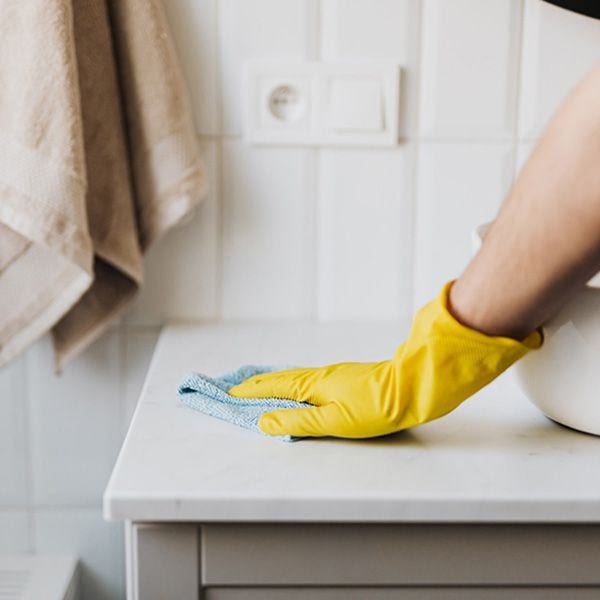The Difference Between Chlorine and Non-Chlorine Bleach
Bleach has been a cleaning staple in America's laundry rooms and bathroom cupboards ever since it was invented in the 18th century. It's commonly used to:
- Remove tough stains from your laundry
- Disinfect surfaces to eliminate bacteria and viruses that could get you and your family sick
- Clean and dissolve heavy grime and built-up dirt
- Refresh your home by getting rid of mold, mildew and odors
- And so much more!
But not all bleach is made alike. In fact, there are two main types that you can choose from when you're doing laundry or cleaning your house. The best type of bleach to use depends on where you're using it, and what type of cleaning task you're tackling today.
Chlorine Bleach vs Non-Chlorine Bleach
Not to get too Bill Nye the Science Guy on you, but bleach isn't a chemical in and of itself. It's simply the generic name referring to the sanitizing and bleaching cleaning product we often use on a recurring basis.
There are two versions you can choose, each with its own distinct pros and cons:
- Chlorine bleach made with sodium hypochlorite
- Non-chlorine bleach made with hydrogen peroxide

Chlorine Bleach
This is the original form of bleach typically used in households across the country. As the bleach that started it all, it has very high oxidation properties. Put simply, when any type of organic material (e.g., dirt, bacteria, mold, grass stains, etc.) comes in contact with chlorine bleach, the bleach's active ingredients break down that organic material into water-soluble components (i.e., it makes it easy to wash away with water).
This makes chlorine bleach highly effective, but it also introduces some toxicity concerns and increases the cleaning solution's wear-and-tear effects on your laundry and home.
Chlorine bleach is best for:
- Maintaining the "brightness" of your white laundry
- Removing stains from white laundry, including difficult stains like underarm armpit stains on a shirt, or spilled red wine on a white pillow
- Disinfecting, deodorizing or cleaning hard surfaces
The drawbacks of chlorine bleach include:
- It's very potent and can weaken the fiber in your clothing and fabrics
- It's very toxic and releases powerful fumes, thus requiring extra safety precautions and lots of ventilation when using it
- It works non-discriminately, so it will remove the dye in your colored shirt as it simultaneously lifts away stains
Non-Chlorine Bleach
Non-chlorine bleach goes by a lot of names. For instance, you might see it marketed as "oxygen bleach." Instead of sodium hypochlorite, non-chlorine bleach uses gentle hydrogen peroxide. This makes the solution less powerful as chlorine bleach, but this also expands where it can be used safely.
Non-chlorine bleach is best for:
- People who are worried about the toxic effects of chlorine bleach
- Cleaning all of your laundry, including colored laundry
- Disinfecting, deodorizing or cleaning hard surfaces
The drawbacks of non-chlorine bleach include:
- It's not as strong, so it may not get out some stubborn stains
- It works slower than chlorine bleach, and you may need to soak your laundry or surfaces longer for it to be effective
- It's not non-toxic, although it may pose less of a risk to your health and the environment
How Do You Know If Bleach Has Chlorine?
Not all bleach has chlorine in it. In fact, more and more cleaning products are using hydrogen peroxide instead.
The label will always indicate if it's a chlorine bleach or a non-chlorine bleach. When in doubt, read the ingredients list: If it is made with sodium hypochlorite, it's a chlorine bleach.
Does Non-Chlorine Bleach Disinfect?
This is where things can get tricky. Hydrogen peroxide, which is used in non-chlorine bleaches, does have disinfectant and sterilization effects. However, depending on the product you're using, it may not be present in high enough concentrations to effectively kill viruses and bacteria.
That being said, some non-chlorine bleaches may also include botanical extracts or essential oils, such as thymol, or other active ingredients that increase the product's disinfectant strength.
If you're looking for a non-chlorine bleach that disinfects and sanitizes, review the product's label to ensure it meets your needs.
Does Non-Chlorine Bleach Whiten?
Yes, non-chlorine bleach will whiten your laundry and remove stains. The hydrogen peroxide in it oxidizes organic material similar to how chlorine does.
However, this process is much slower and weaker when using hydrogen peroxide instead of chlorine. This makes non-chlorine bleach safer for colors, but it also means it may require repeated bleaching to tackle deeply set stains.
How Do You Use Non-Chlorine Bleach?
You can use non-chlorine bleach the same way you would any other form of bleach. Try these cleaning tips and tricks to effectively use non-chlorine bleach:
- Always color-test your fabrics before using it (dap a drop or two on a discrete part of your garment to see if the bleach fades your color).
- Use warm or hot water, since hydrogen peroxide isn't as effective in cold tap water.
- Add the non-chlorine bleach to your washing machine before adding clothes in order to let the bleach circulate through the wash more efficiently.
- Let your laundry soak a little longer than you normally would to give the non-chlorine bleach time to do its thing.
Shop Non-Chlorine Bleach with Co-op Market
Give non-chlorine bleach a try today. Whether you're seeking an all-purpose laundry whitener that's safe for all your fabrics, or you're worried about the environmental and sustainability impact of your laundry products, green and sustainable cleaning products can keep your home sparkling.








